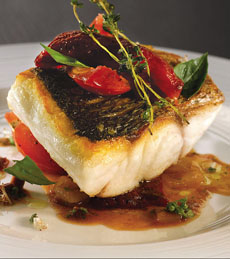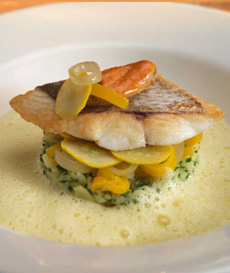HOW TO FLAMBÉ
If you haven’t flambéed before, you should practice igniting alcohol before the big event. Remember to be cautious; you are, after all, “playing with fire.”
To flambé, you need a liquor or liqueur of 80 proof or higher; the higher the proof, the more easily it ignites. You can easily find them at 100 proof or more.* But 80 proof will do; and for those concerned about ingesting the alcohol: most of it burns off in the flames. It does leave some flavor, so choose a liquor/liqueur that is complimentary to the food (chocolate or fruit liqueurs or brandies for desserts and whiskey or brandy for meats).
If you want, you can embed a small metal cup in the top of the volcano (think the something smaller than a tea candle—we used a repurposed bottle top from an empty bottle of Scotch). It will make the flames “spout from the volcano.” You need to embed it as you are mounding the ice cream.
It also helps to dim the light in the room. Then, just before serving:
1. PLACE 1/4 cup liquor and a small metal ladle in a small saucepan. Heat the liquor and the ladle just until the liquor begins to bubble, around 130°F. You will to see vapors rise from the liquid. It must be warm to ignite; but do not allow the liquor to boil off, or it will not stay lit (the boiling point of alcohol is 175°F).
Option: The liquor also can be heated in a microwave oven in a microwave-proof dish for 30 to 45 seconds at 100 percent power. You can warm the ladle in boiling water.
2. WITH A CUP: Ladle part of the liquor into the metal cup and ignite it with a long “fireplace” match or barbecue lighter. As the liquor burns, fill the warmed ladle half full with more of the warmed liquor and drizzle it slowly into the eggshell, raising the ladle as high as you safely can. The flame will go out by itself when the alcohol burns off.
Be sure to ignite the dessert away from guests and flammable objects. A serving cart or other rolling cart is a great idea here.
WITHOUT A CUP: Pour the liquor around the base of the volcano and ignite immediately so the raw alcohol doesn’t seep in to the food. Or, douse sugar cubes in the alcohol briefly—you want the alcohol to absorb but not to cause the cubes to fall apart. Place the cubes around the perimeter of the dish and light.
3. SERVE as soon as the flames disappear.
__________________
*Examples of higher proof alcohol: Absolut 100 Vodka (100 proof), Booker’s Bourbon (121 proof), Laphroaig Cask Strength Scotch Whisky (114 proof), The Macallan Cask Strength Scotch Whisky (116 proof), Plymouth Navy Strength† Gin (114 proof), Smith & Cross Traditional Jamaica Rum (114 proof), Stolichnaya 100 proof. Note that liquors above 120 proof are highly flammable and considered dangerous when lit.
†FUN FACT ABOUT BRITISH NAVY-STRENGTH GIN: The liquor on warships had to be at least 114-proof. Why? It is the proof level at which the ship’s gunpowder could still be fired should when soaked with booze. The gunpowder was used by the pursers to test that the level of alcohol in the gin was what they had paid for.
|







